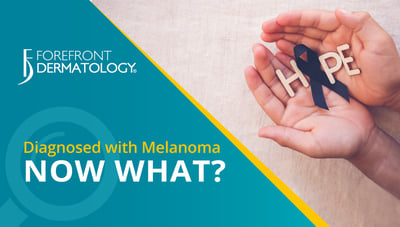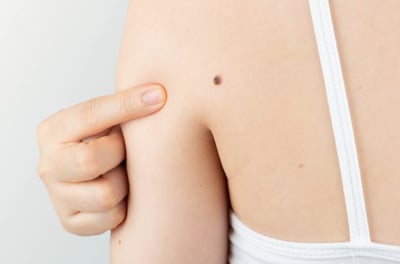
Your skin is your largest organ and plays a vital role in detecting hot and cold, regulating your body temperature, and protecting your muscles, bones, and internal organs from outside infection and disease. Protecting it becomes your job, and one of the most important concerns you need to protect it from is melanoma skin cancer. Did you know that one in five Americans will develop skin cancer in their lifetime? Here are some of the most interesting, and important, melanoma skin cancer facts you need to know:
About Melanoma
- Melanoma is a highly malignant skin cancer that spreads rapidly and widely.
- Skin cancer is defined by two categories, melanoma and non-melanoma.
- While it can develop anywhere on the skin, Melanoma is more likely to start on the chest and back in men and on the legs in women. The neck and face are other common sites.
- Scalp melanomas are more lethal than other melanomas. One nationwide study found that people with scalp and neck melanomas die from the disease at nearly twice the rate of people with melanomas elsewhere on the body. This is likely due to the inability to spot it as easily as other locations.
- Lentigo maligna melanoma is an in situ melanoma that is commonly found in the elderly as a result of long-term sun exposure.
- Nodular melanoma is usually invasive by the time it is diagnosed. The malignancy is recognized when it becomes a bump. It is usually black but occasionally is blue, gray, white, brown, tan, red, or skin tone. This is the most aggressive of the melanomas and is found in 10 to 15 percent of cases.
- Acral lentiginous melanoma is also in situ and spreads superficially before penetrating more deeply. It is quite different from the others as it usually appears as a black or brown discoloration under the nails or on the soles of the feet or palms of the hands. This type of melanoma is sometimes found on dark-skinned people, and tends to advance more often than superficial spreading melanoma and lentigo maligna because it is detected later.
Melanoma Statistics
- The American Cancer Society estimates 100,640 new melanomas will be diagnosed in 2024, with 8,290 people expected to die as a result of melanoma.
- According to American Cancer Society research, if melanoma is caught in stage one, the 5-year survival rate is 97%. Late detection survival rates can be as low as 15%.
- Melanoma can occur in a variety of colors including brown, black, red, blue, or purple. These spots can be flat or raised and can bleed easily.
- According to the American Academy of Dermatology, 1 in 50 Americans will develop melanoma in their lifetime. It is the fastest-growing cancer in the U.S. and worldwide.
- According to the American Academy of Dermatology, Melanoma is the second most common of all cancers in men and women ages 15-29.
- According to the American Cancer Society, Melanoma is more than 20 times more common in whites than in African Americans. Overall, the lifetime risk of getting melanoma is about 2.6% (1 in 38) for whites, 0.1% (1 in 1,000) for Blacks, and 0.6% (1 in 167) for Hispanics.
- One study has shown that only 20 to 30 percent of melanomas are found in existing moles, while 70 to 80 percent arise on apparently normal skin.
- According to the American Cancer Society, The estimated five-year melanoma survival rate for Black people is only 67 percent, versus 92 percent for whites.
- Studies show that individuals who use tanning beds under the age of 35 increase their risk of melanoma by 75 percent.
- Research has shown that yearly more than 400,000 cases of skin cancer in the United States are linked to the use of indoor tanning beds.
Melanoma Stages
- Stage 0 Melanoma is in the outer layers of the skin. Treatment in this stage often cures the patient of melanoma.
- Stage 1 Melanoma is in the outer layers of skin (epidermis) and sometimes the upper part of the inner layers (the dermis). A cure is often possible.
- Stage 2 Melanoma is found in the outer layers of skin and in the lower layers of the dermis. The likelihood of a cure is still good.
- Stage 3 Melanoma: the cancer cells have spread beyond the skin and are found in a lymph node(s) or lymph vessel(s) closest to where the melanoma began.
- Stage 4 Melanoma: the cancer cells spread beyond the closest lymph nodes to one or more parts of the body.
Melanoma, Genetics, and Childhood
- Melanoma primarily occurs in adults, but an average of 300 children are diagnosed with pediatric melanoma in the United States every year.
- Just five blistering sunburns can increase a child’s risk of developing melanoma by 80 percent.
- While melanoma is the least common type of skin cancer in adults, skin cancer in children is almost always melanoma.
- Blistering sunburns in early childhood increase risk, but sunburns later in life and cumulative sun exposure also increase your chances of developing melanoma.
- People with fairer skin are at an increased risk of melanoma skin cancer, but this does not eliminate other skin tones from having a risk of skin cancer.
- Genetics plays a large role in melanoma. Approximately 1 in every 10 patients diagnosed with the disease has a family member with a history of melanoma.
- According to the Skin Cancer Foundation, research shows if you have an immediate relative who has melanoma, you are in a melanoma-prone family –with a 50 percent greater chance of developing the disease.
- Anyone who has more than 50 moles is at a greater risk for melanoma, but having less does not eliminate you from developing it.
These life-changing statistics are just some of the many important pieces of information you should know about melanoma skin cancer. Forefront Dermatology’s skincare experts are here to help examine your skin for any signs of skin cancer. Remember, early detection saves lives. If you have any concern about a spot or mole on your or your child’s body it is best to schedule a skin cancer examination with your local board-certified dermatologist immediately. It may be nothing, or it may be something. Put your mind at ease, find a dermatologist near you today.
To learn more about skin cancer we recommend visiting the following websites:





